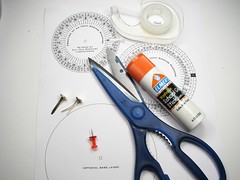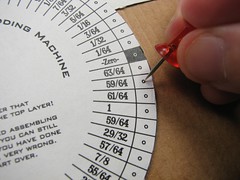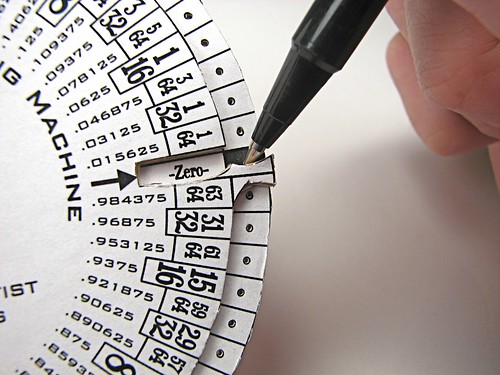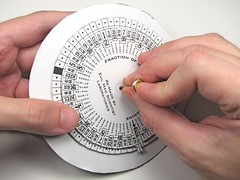Last weekend we took a trip to Urban Ore in Berkeley, where I found an incredible gem: this “Fraction of an Inch Adding Machine.” It’s a simple to use device that lets you add any number of fractions– from 1/64 to 63/64– quickly, automatically, correctly, and without thinking about it.
As proudly proclaimed on the bezel itself, this calculator design is covered under patent Des. 169941, submitted in 1952, and granted a 14-year term in 1953. Forty years after the patent has expired, it’s painfully obsolescent, and yet remarkably charming. The design is so simple and so obvious in how it works, and yet… there’s something almost magical about it.
But enough talk. Want to play with one? Using our pdf pattern and some office supplies, you can make a working replica in 5-10 minutes and try it out yourself!
The first thing to do is to download the design here (430 kB PDF document). Print it out on an inkjet or (preferably) laser printer.
There are a few different ways to build your adding machine; we’ll point out some of the possible variations as we go along. In particular, the machine may be built with or without the largest of the three wheels that appears on the pattern.
We will need some simple tools for this project. Most importantly, we’ll need scissors, a basic pushpin (or other pointy object) and a brass paper fastener of the type pictured to the upper right.
I also used a glue stick, regular tape, a hobby knife, a cutting mat, superglue, and the paperboard from an old cereal box. (If you don’t have any of the latter items, keep reading– you can still make a working model without them.)


Take your printed pattern and *roughly* cut out around the three shapes, leaving 1/8-1/4″ border around the edges of each shape. We’re going to attach them to a piece of thin paperboard to provide rigidity to our wheels. I actually used some ultra-thin (1 mm) corrugated cardboard that came from a cereal box. But… use whatever’s handy.
Using a glue stick, rubber cement, or double-sided tape, attach the three shapes firmly to the paperboard. The glue stick worked great, and was ready to cut immediately after application.
Carefully cut out the shapes on the paperboard, cutting all the way down to the outlines this time.
You may find it helpful to use a hobby knife for some of the finer detail, particularly on the smallest (top) wheel.
Then, cut out the the small circle in the center of each of the three wheels.
There is one step remaining to complete the lower disk, which is to put a physical hole through each of the 64 holes drawn around the perimeter. To make the holes, place the disk atop a some corrugated cardboard (that you don’t care about) or a corkboard, and push the pushpin through each of the holes once. (This is a very fast procedure in practice.)
Stack the two smaller wheels, small one on top (it says “Re-Made by Evil Mad Scientist Laboratories” on it) and insert the brass fastener to keep the two wheels together. Splay the two tabs of the brass fastener on the back side. Note that the cheerful folks on the back of my calculator are a side effect of using a cereal box. Your cartoons may vary.
The completed 1952 Fraction of an inch adding machine!
(You may notice that we didn’t use the largest of the three wheels– it’s an optional upgrade that we’ll get to shortly.)
Serious Shortcut: If you are short on time and/or office supplies, you may wish to build the quick minimalist version (shown in the two photos above) instead of the version described in all the steps above– Use scissors to cut the top two shapes out of the printed PDF pattern and connect them together with the brass fastener. It’s floppy but functional.
Next, let’s see how to use it.
When we first start to use the machine, the black segment on the outer ring is in some arbitary location.
Insert the point of a ball-point or roller ball pen into the hole of the black outer segment.
Holding the inner wheel, use the pen to rotate the outer wheel CLOCKWISE until you come to the stop.
When you have reached the stop, notice that the window with the arrow reads “Zero.” The calculator is now ready to use. We’ll do an easy one first: 1/8″ + 3/16″.
To enter the first operand, 1/8″, take the pen out and put it in the hole on the outer rim corresponding to 1/8″.
Now, use the pen to rotate the outer disk CLOCKWISE until you come to the stop. Note that 1/8″ is now displayed in the window with the arrow.
To enter the second operand, 3/16″, take the pen out and put it in the hole on the outer rim corresponding to 3/16″.
Next, to actually perform the computation, use the pen to rotate the outer disk CLOCKWISE until you come to the stop.
The number displayed in the window with the arrow is the answer: 5/16″. You can of course repeat this procedure, adding as many other fractions together as you like.
(Note: The window only displays the fractional part of the answer. If your fraction is larger than one inch, you will need to keep track of the whole number part. If your adding operation generates a “carry,” the black bar on the outer ring will pass the arrow and window as you slide the ring clockwise– see the second demonstration below for an example.)
Next, let’s add in the optional base, and show how that’s built:
Assemble the stack of three wheels, using the brass fastener to hold the stack together as before. What’s different now is that we need the upper wheel and the lower wheel to be fixed together, and the middle wheel (the one with the holes around the edges) is free to turn with respect to the outer two.
On the back of the optional base, bend down the sides of the brass fastener as before; leave some slack in it to reduce the amount of friction between layers. Use a piece of tape on the back side to hold the two leaves of the brass fastener fixed in place.
On the front side, use glue to hold head of the brass fastener fixed with respect to the top wheel. If you’ve used thick paperboard or cardboard for the wheels, you can do this with a tiny drop of superglue.
And here is what the completed adding machine looks like with the optional base installed. This version is easier to use because you merely need to hold the outer ring while you move the middle wheel with the pen.
Let’s give one more example of how to use the adding machine, now demonstrating with this version with the base. To generate an answer that is larger than one inch, let’s add 13/16″ and 1/4″.
Again, to initialize, we point the pen into the black segment and drag it clockwise until the stop.
We are now zeroed, and ready to enter the first operand.
Here is 13/16″, which we again drag clockwise until we reach the stop.
As you can see, 13/16″ is entered and shows up in the window.
Our second operand is 1/4″. Note that when we put the pen there, the black segment in the outer ring is between the pen position and the arrowed window– when we drag, it will cross zero.
Again, drag clockwise until we reach the stop. In doing so, the black segment has passed the arrowed window– indicating that we’ve carried a digit. The answer displayed in the box is 1/16″, and, since we’ve carried a digit, the answer is actually 1 1/16″. Neat.
So that’s how to build and use your own replica of the 1952 Fraction of an Inch Adding Machine. Have fun with it!
Update Nov. 2014: by request, we’re posting the Inkscape file alongside the PDF:
Inkscape file for Fraction adder (1.4 MB SVG)
PDF for Fraction adder (430 kB PDF)








































I think the 15/16 slot is mistyped. It says 1.
Thank you so much for catching that– I’ve fixed it in the PDF.
It was bound to happen– and there may be others. (I entered all of the numbers by hand, very, very late at night.)
—
Windell H. Oskay
drwho(at)evilmadscientist.com
http://www.evilmadscientist.com/
How did you generate the disks? Did you use a drawing program or generate them in PostScript (the latter being a fav of mine, http://www.flickr.com/photos/funnypolynomial/301547940/in/set-72057594111715233/)?
f(p)
I used inkscape, my favorite open-source drawing tool. If you (or anyone else) would like the original inkscape .svg file, I’ll be happy to E-mail it to you– contact me via the “Contact” button at the top of the page. (It’s ready to distribute, but I didn’t want to post two files in the article.)
I’ve dabbled in postscript, but written anything from scratch myself. In grad school, I worked with some amazing phase space simulations and computations written in postscript by Dan Steck.
—
Windell H. Oskay
drwho(at)evilmadscientist.com
http://www.evilmadscientist.com/
I think you made another mistake. On the lower disk where 31/32 should be you have 59/64.
It’s a pretty cool gadget for us, metric people.
Zé Maria
D’oh! (fixed)
—
Windell H. Oskay
drwho(at)evilmadscientist.com
http://www.evilmadscientist.com/
I too would love to know how the copy was created. Either that or I would love a high res version so that I can make a really big one for my class!
As I said earlier, I drew it in Inkscape, and I’d be happy to send the original (editable) file to anyone who E-mails me individually.
Also, the PDF that I posted is vector art– which means that it has infinite resolution. You can blow it up as large as you want, and you won’t ever see pixels or lose clarity. Just print it big!
—
Windell H. Oskay
drwho(at)evilmadscientist.com
http://www.evilmadscientist.com/
Yeah, just thought about it myself. Never could get a grip on imperial units.
Imperial ! Ahrr Ahrr ! I always carry in my hands my own personal "decimal" adder :) !
Alessandro.
So cool, thank you ! I sent this to my son’s math teacher. :)
Instead of using a brad in the center, one can use an "eyelet". Go to any arts and craft store, enter the scrapbook making section, and get some eyelets and an eyelet setting tool.
And those of us that hang out at the hardware and electronics stores can use tiny nuts, bolts, and washers as well.
—
Windell H. Oskay
drwho(at)evilmadscientist.com
http://www.evilmadscientist.com/
This is great!
I laminated mine instead of gluing it onto cardboard. Worked fine and the surface is protected against pen marks too.
This is such a neat little DIY device. I keep looking for excuses to use it. Thanks for creating & sharing! ~ Evil Jim
…should be a log-log circular slide rule.
Maybe so, but I was thinking about doing a linear one first. =)
—
Windell H. Oskay
drwho(at)evilmadscientist.com
http://www.evilmadscientist.com/
An extra added bonus: After you enter the first operand, the black mark is located at the value of (1 – value of first operand). Nice.
In most cases, this is probably faster than doing a fraction problem on a hand calculator.
It looks like it could also be used to SUBTRACT; by starting at the fraction value being subtracted from, and rotating the wheel counter-clockwise until it lines up with the fraction value you are subtracting.
How true! That’s a really good suggestion!
—
Windell H. Oskay
drwho(at)evilmadscientist.com
http://www.evilmadscientist.com/
I found a typo. 9/16 is .5625
Made two tonight .. fun! Gave one to my bro in law.
Made a couple of these recently and used the clear discs you get in a cd/dvd spindle as backing plates for them, made them a bit sturdier.
my little girl had a project to do one one of them was to create a machine from a cereal box using
fractions,decmials and or percents and we looked all over the internet for help and didn’t find no help until this morning on this website thank you so much and oh yea she is a sixth grader….
AND YOU CAN EMAIL ME AT:TAMIKAWEAVER@HOTMAIL.COM